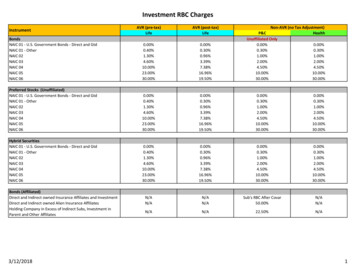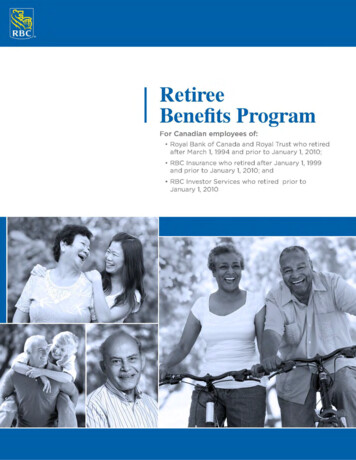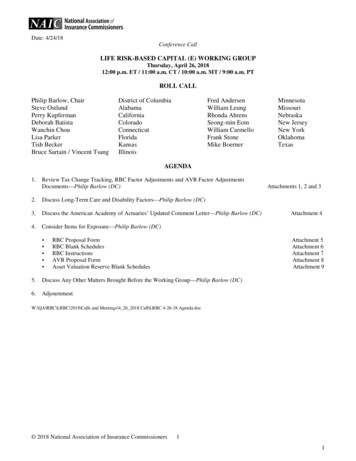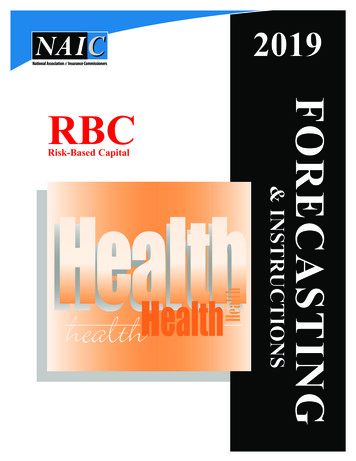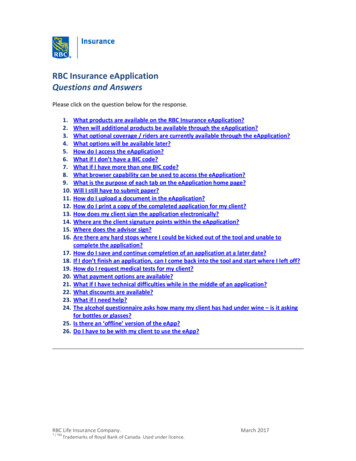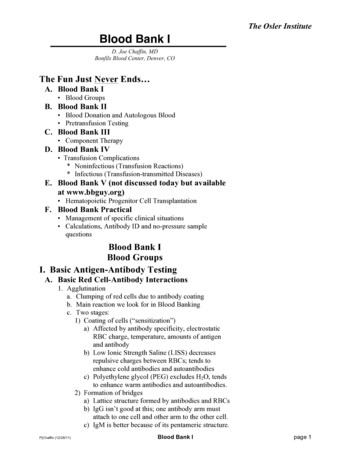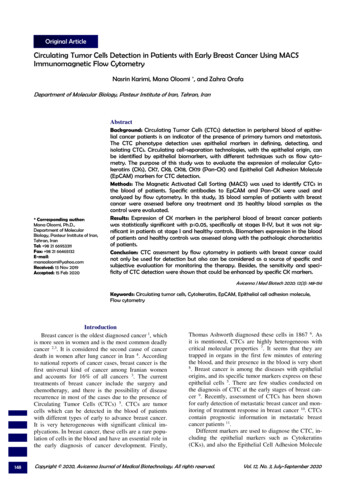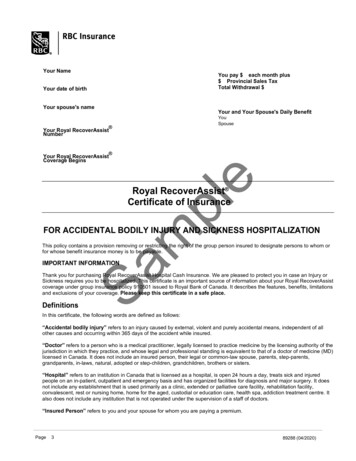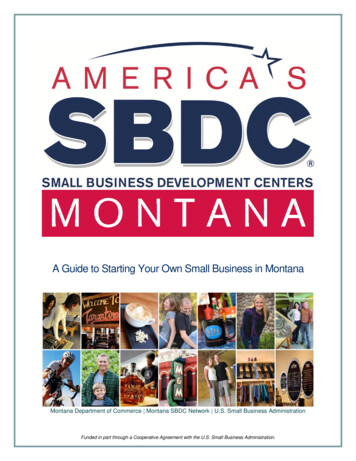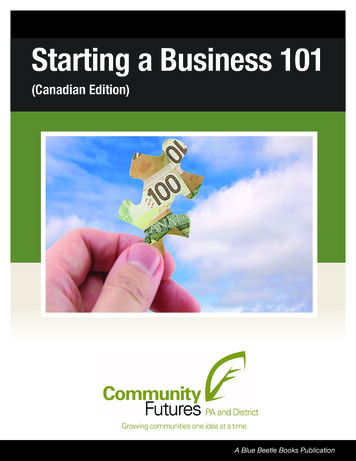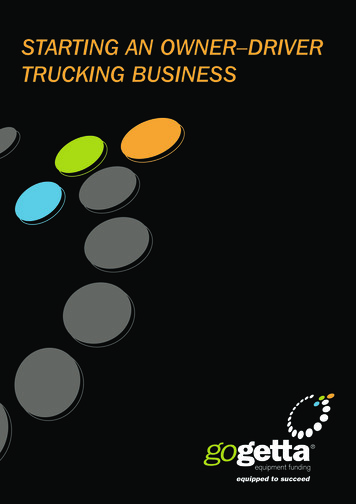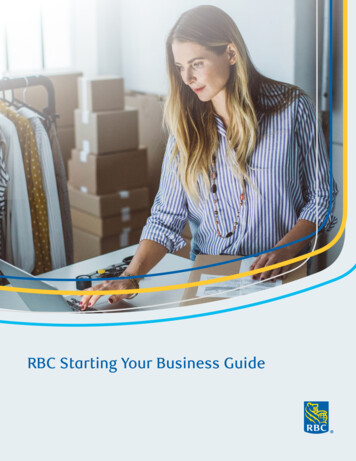
Transcription
RBC Starting Your Business Guide
RBC Starting Your Business Guide 1Making your business a realityThis guide is split into 6 sections;¡ Making sure your business idea will fly¡ Finding the money to start¡ All the legal stuff you need to know¡ The best ever business plan¡ Keeping control of your cash¡ Help and adviceFor additional advice on starting your business, visit anyRBC Royal Bank branch – find the nearest one atrbcroyalbank.com.
1 RBC Starting Your Business GuideSection oneMaking sure your business idea will flyBefore you start operating, check the feasibility of your idea.1. Develop your competitive advantageWhat are the core products and services that will underpinyour business, and are you significantly better than thecompetition? Or is there a gap in the market that you’veidentified that no one else is filling?What is your key advantage?¡ F orm strategic alliances: key partnerships with otherbusinesses that you can bring to the table¡ C oncentrate on convenience: you’ll deliver, do it sooner,travel, have parking, use technology to track orders2. I dentify your target customersand their needsWhy are you better, or different, than your maincompetitors?If you have a clear idea of who your customers will be,it will be easier to position your product or service for thisparticular group of people or businesses.Think about how you can differentiate yourself such as:The best customers will:¡ Provide a new product or service that isn’t offeredanywhere else¡ Understand of the value of what you offer¡ Find a great location, excellent for customerconvenience and traffic¡ Be loyal, return again and again, refer business andpay on time¡ Employ friendly staff that are well known in theindustry and potentially have a number of customersthat will follow them to your business¡ O ffer online services like ordering, customer tracking,industry news, social media updates¡ Develop a reputation as the expert so customers wantto be associated with you¡ Have the highest potential for sales growthTIP: It’s better to have 3-5clear customer targets thatyou can focus on, rather thantrying to sell to everyone.
RBC Starting Your Business Guide 23. Conduct market researchUnderstand your market and how your customers willperceive your business. Find out some of the fundamentalinformation about the market you will operate in:¡ What is the size of the market, and what percentage ofsales do you think you’ll get?¡ Who are the key competitors in the market?¡ Where are most of your customers, and are they easyto communicate with?¡ What will customers pay, and can you make a profit?¡ How will customers want to pay you?¡ H ow do customers want to receive their products andservices?Six low-cost ways toresearch your market1. Search for industry information. Look online,such as on the websites of Statistics Canada,trade associations, Industry Canada, or attendevents, conferences and talk to other businessowners.2. Survey potential customers. Walk around theneighbourhood where you’ll be operating. Askpotential customers what they like anddislike, and how they make buying decisions.3. Talk to experts. Consultants, professors,journalists and experts are constantly writingwhite papers and commenting on specificindustries.¡ Can you get the right suppliers?4. Seek intelligence from non-competing markets.Study companies with similar products orservices in other cities or countries.Answering these questions will help you start to build theidea of your business model and determine whether youcan deliver what your customers need.5. Study your competitors. Look at their ads,examine their websites, check out theirproducts and in-store displays, sign up fortheir e-newsletters.¡ What support do customers expect?6. Talk to suppliers. While you may not learn anytrade secrets, their conversations could providevaluable insights into the industry as a whole.4. Your business modelYour business model is the distribution or selling methodthat outlines how you intend to go to market.Examples of business models:¡ Retailing: You buy products from a wholesaler, add amargin and then resell them. Retailing usually involveshaving a physical storefront but can also include anonline store.¡ Online trading: You buy and sell online without anyphysical premises. If you sell to the end consumer,it’s a variation of retailing.¡ Construction: You contract to build a structure byproviding an estimate or submitting a quote in a tenderprocess, or you may sub-contract to a larger business.¡ Wholesaling: You import products, add a margin andthen resell them to retailers or suppliers.¡ Franchising: A franchisor sells the business conceptto you, the franchisee, and you buy into the brand andoperate the business under the guidelines ofthe franchisor.¡ Software: You either provide software and customers payyou a one-time fee, or they pay a licence/subscription feeto access the software on a regular basis.¡ Manufacturing: You buy components and assemble/create a products(s) and then sell it (them) to adistribution network.¡ Professional services: You provide specialist servicesto customers who pay you for your expertise.Other business models include:¡ Licensing: you own the intellectual property andcustomers pay you a fee, such as providing a recipeto a food manufacturing business.¡ Affiliates: you resell other businesses’ products andtake a margin, or in reverse, you offer your product orservice and others sell it on your behalf.
3 RBC Starting Your Business GuideTIP: You don’t have to stick to just one business model. For example a traditionalretail location may also have an online store, source unique products and sell toother retailers.5. Finding the right suppliers and logisticsOther factors to be aware of:Being in business successfully is all about making sureyou can deliver. Regardless of the business you are in,you will need:¡ Freight (freight forwarders, customs brokers, transportcompanies, couriers, air express companies, airlines,shipping companies and others in the freight industry)¡ R eliable suppliers: other businesses that can deliverthe quality and price you require on a consistent andregular basis. Get multiple quotes from suppliers, checktheir credibility and ask about their ability to scale up,in case you suddenly need to order larger quantities.¡ Returns: either customers are not happy with thefinal product, or you are not happy with what youare receiving¡ A n understanding of the business process: the logisticsinvolved in getting products and raw materials fromsuppliers to your business, and then delivered to thecustomer. Sketch a flow chart of the various processparts to confirm the flow is smooth and to spotpotential bottlenecks.¡ Storage of finished products¡ I nsurance coverage for the time when the productleaves your business to when it arrives safely at thecustomer¡ Packaging, balancing protection with cost¡ Documentation if you are importing or exportingTIP: Having great supplier relationships is an important part of being in business.Be more than another customer to them. The more you sell their product oruse their service, the more revenue they will make, and the better service youwill receive.6. Understand your capabilityand capacityYou need to be sure that you have the capability and thecapacity to start and run your business profitably.You need to consider¡ Whether you will be able to invest in more capacityif you need to. If you manage to secure a large order,can you scale up to fulfil it? What extra equipmentor products do you need?¡ How much of a financial investment will be required tomeet customer needs. If your business starts to growfast, having the cash available to add staff andincrease production volume is crucial.¡ Whether you’ll need additional staff. Can you secureskilled employees on short notice?¡ How to source alternative suppliers. Good contingencyplanning should include alternative sources of supplies.¡ How you will maintain quality and consistency.Quality issues can occur when you are producing largervolumes, and the last thing you need is for a wholeshipment to be rejected because it is substandard.¡ How you will manage your growing business. It isimportant to have good project management systemsin place, and to know when you may need to hireoutside help.¡ Whether you will outsource to other businesses.Not just in Canada but also offshore if there are cost,product or speed benefits.¡ How long it will take to get paid. There may be aconsiderable gap between securing an order or workand getting paid. Estimate what you think you’ll need tomake your business a reality, and where the money willcome from.
RBC Starting Your Business Guide 4Section twoFinding the money to start1. Figuring out how much money you needEstimating your start-up costs falls into two categories:set-up costs (how much money you need before you startoperating) and initial cash flow (the money you need afteryou’ve started until you start making a profit).Set-up costsThese are one-off costs that are required for you to launch,and which you probably won’t have to pay for again. Everybusiness will have different start-up costs to considerdepending on the industry.Start-up costs might include:¡ Rent deposits and any building renovations beforeyou start¡ Licences and permits¡ Equipment such as computers and software plusoffice supplies¡ Equipment for speciality work such as tools,a vehicle, etc.¡ Insurance¡ Employee recruitment and training¡ Initial inventory or raw materials¡ Marketing materials and advertisingTIP: If you are buying abusiness (including afranchise), the purchase pricebecomes your set-up costsfigure, as usually all thesecosts are included in theasking price.Initial cash flowMost businesses need time trading before they startcovering all the overhead (and making a profit). Until thishappens you should have cash in the bank (also called“working capital”) to pay your expenses until you areoperating at a profit.
5 RBC Starting Your Business GuideCreate a cash flow forecastSet-up costs exampleA builder needs 150,000 for equipment and overhead cash of 15,000/month (including a working salary), and it will taketwo months before the first building contract payment is received.Without start-up capitalRevenues from salesSet-up costsJanuaryFebruaryMarchApril 0 0 45,000 45,000( 150,000)Overhead expenses( 15,000)( 15,000)( 15,000)( 15,000)Cash flow( 165,000)( 15,000) 30,000 30,000Cumulative cash balance( 165,000)( 180,000)( 150,000)( 120,000)JanuaryFebruaryMarchApril 0 0 45,000 45,000With start-up capital of 200,000Revenues from salesStart-up capital 200,000Set-up costs( 150,000)Overhead expenses( 15,000)( 15,000)( 15,000)( 15,000)Cash flow 35,000( 15,000) 30,000 30,000Cumulative cash balance 35,000 20,000 50,000 80,000TIP: Sales forecasting is hard for you as a start-up because you usually don’thave any past sales to use as a benchmark. Try to estimate what similarbusinesses might generate (number of employees x hourly rates, hours open,number of contracts, outlets), and see if there are any statistics on averagesales for your industry. If that fails, add in what you MUST sell to cover costs.Now you have a target.2. Where to get the money you needNow that you have figured out how much money you need,you should make some decisions about where that moneywill come from.Your own moneyHaving some of your own money (savings or equity inproperty) to invest in your business makes sense. It showsyou have skin in the game and are prepared to back yourbusiness with your hard-earned cash. Why your own money?¡ L east costly source – it’s the cheapest form of financingyou will find. You can put cash, investments, equity inyour home or other personal property to work for you.¡ Makes you a better risk for lenders – if you risksomething yourself, others may feel better taking onsome of your risk. So your investment improves yourchances of getting a loan.¡ You don’t need to sell your assets – you can get asecond mortgage or open an RBC Homeline Plan lineof credit on your home or use other investments assecurity for a business loan.Friends and familyAsking friends and family is a common way to accessthe cash you need. But if you choose to ask family forfinancial assistance, make sure the loan is short termand you can pay them back quickly. This will makefuture family gatherings much more comfortable.
RBC Starting Your Business Guide 6Other sourcesGovernment grants and subsidiesOutside investorsThe Government of Canada can provide funds for businessesif you qualify. This includes loans, grants, loan guaranteesand other initiatives. View the Canada.ca site for more onbusiness grants and financing.Often called “Angel” investors, people in search of investmentopportunities. In return, they usually expect a share in yourbusiness, possibly a percentage return on the money they’velent you, maybe both. Search for angels in the National AngelCapital Organization member directory.Venture capitalistsVenture capitalists are companies (not people) thattypically invest in young companies they think will be soldto the public, or to a larger company, at a high rate ofreturn. They rarely invest in an untested idea, preferringbusinesses that can demonstrate rapid, consistent growthand guarantee a worthwhile return. Search for VCs in theCanadian Venture Capital Association member directory.CrowdfundingDescribed as “democratic finance”, crowdfunding allows youto profile your business and attract investment (or loans)from a range of different people who wouldn’t normally beeligible to invest in new businesses without a prospectus.To work, crowdfunding needs to be exempt from securitylaws. The National Crowdfunding Association of Canadais a good place to start.BorrowingChances are you will need to borrow money (either a loanto pay back over time or an overdraft facility that lets youdip in and out of debt when you need it). Before you applyfor business financing, it’s important to have all yourfinancial information in order, including:¡ Purpose – exactly what you will do with the cash¡ Sources of funding – how much you think you’ll needto borrow, and how much you’re contributing yourself¡ Loan security – what you’ll use to secure the loan ifanything¡ R epayment plans – how you intend to repay the loanand reflect the repayment schedule in your cash flow¡ Existing debt – what other debt you have that mayimpact your ability to repayTIP: RBC has a number of business loans and lines of credit to help with all ofyour finance needs, from start-up costs to ongoing cash needs. For example, ourRoyal Business OperatingLine offers a credit line that’s ideal if your business isbrand new and doesn’t have a business credit history.
7 RBC Starting Your Business Guide3. Matching money to the needIt’s important to link the money you need to the use and cost. As a rule of thumb use the method that matches the life of theasset: a credit card or overdraft could be used for short-term needs (like buying extra inventory or materials), and loans andoperating lines could be used for long-term needs (such as equipment and commercial property).What do you need money for?I need money to cover short-termexpenses like supplies, payroll and rentuntil my sales turn into real cash.Possible solutionBusiness lineof credit¡ You are approved to borrow a set amountin advance.¡ You can pay it down as cash comes in.I need money to market the start-upphase of my business and generate sales.¡ You pay monthly interest on the amountsborrowed.My business is seasonal and I need moneyto get through seasonal slow periods.I need to be able to cover and trackshort-term expenses like office suppliesand business travel.How it works for you¡ You may be offered a credit card foradded convenience.Business creditcard¡ Track expenses for planning andrecord-keeping separately from yourpersonal expenses.¡ Make purchases interest-free untilpayment is due.¡ Some cards allow you to earn rewardpoints, which can be rolled up fromemployee cards or combined with yourpersonal card points balance.I need money to buy hard assets thatare necessary to operate my business,like buildings, vehicles and equipment.Term loan¡ Pay off over a longer time period to avoidtying up your credit line/cash flow.¡ Regular payments make it easy toforecast cash flow.¡ Match the term of the loan to the life ofthe asset – pays for itself over time.I need to have access to cash whenunexpected expenses arise, while keepingmy credit rating intact.Overdraftprotection¡ Comes into effect automatically, up toyour pre-determined limit, whenever youraccount is overdrawn.¡ Easy to repay – deposits are applied toyour overdrawn balance.
RBC Starting Your Business Guide 84. Monitoring your business performanceThe basic tools of financial managementSuccessful business owners know that having an accurate snapshot of how their company is doing financially is key to beingable to manage effectively. If you can identify there is a problem daily/weekly, it gives you the chance to correct it immediately.What thetool showsToolsThe “books”. These can be a simple cashbook or Excel spreadsheet.Preferably you will use accountingsoftware linked to your bank accounts.Cash flow statement. If you haveaccounting software, you can producea statement any day you need it.How the tool can help your businessIncoming andoutgoing cash inspecific expenseand revenuecategories¡ Tells you what days/months are the busiest.The differencebetween cash infrom sales andcash going out¡ Indicates how much cash you have on hand.¡ I dentifies which products or services sellthe best.¡ H ighlights if you’re making a cash surplus/deficit each month.¡ A llows you to forecast cash flow needsin advance.¡ E stimates shortfalls in advance so you canplan a solution.Income or Profit and Loss Statement.Balance sheet.Your actualprofit, which isall your income,less all theexpenses youare allowed toclaim for thatyear¡ Breaks down revenues and expenses intoproduct/service categories to show youwhat makes the most money and whatdoesn’t.Your business’sassets, liabilitiesand net worth(which is thedifferencebetween yourassets andliabilities).¡ Shows an overall picture of your businessat the end of the financial year.¡ A llows you to compare each year’sperformance.¡ A llows you to compare each year’sperformance such as inventory levels, cashon hand, debt, retained earnings, drawingsby owners.¡ E nables you to assess the stability of thebusiness.TIP: If you offer credit, cash may not show up for 30, 60 or 90 days. Try to getdeposits or partial payments, implement a debt collecting policy early in yourbusiness and restrict who you give credit to.
9 RBC Starting Your Business GuideSection threeAll the legal stuff you need to knowMake sure you’re compliant with any bylaws and licensing,and that you have all the relevant permissions you needto operate.(CRA) for GST/HST (Goods and Services Tax/Harmonized SalesTax), a payroll account (if you have employees), a corporateincome tax account and an import/export business account.There are five main legal aspects to consider.In order to apply for a BN, you will need your Social InsuranceNumber (SIN), business name, business physical location andbusiness activity, business structure and year end.1. Registering your businessBusiness numberIn Canada, the federal government assigns a unique BusinessNumber (BN) to each company. A BN then allows you toregister a business account with the Canada Revenue AgencyWhat you need to register forFederal¡¡¡¡Corporate income taxGST/HSTPayroll deductionsImporter/exporter incomeProvincial¡¡¡¡¡Business namesWorkers’ compensationHealth taxesProvincial sales taxEmployment standardsMunicipal (may require)¡¡¡¡Business licenceFire safety inspectionHealth inspectionApproval of any changes you make tothe space where you operateThe CRA can be reached at 1-800-959-5525 or throughcra-arc.gc.ca.In Quebec, contact the Ministère du Revenu du Québec:1-800-567-4692 or revenu.gouv.qc.ca.Where you need to registerRegister with Canada Revenue Agency for your Business Number– which registers you for all four purposes listed on the left – .Go to the Canada Business website at canadabusiness.ca to findthe requirements for your province or territory and sector.Consult with local municipal offices to determine localregulations and licensing requirements. Also check that yourbusiness does not contravene any zoning or land use bylaws.
RBC Starting Your Business Guide 10Business nameIf you form a corporation, then you’ll need to register yourname to check it isn’t already taken, and to prevent anyoneelse from copying you. Search the corporate databaseto check your preferred company name hasn’t alreadybeen taken.Once you’ve decided on a name, you can apply forcorporate name pre-approval, and then incorporate on theGovernment of Canada site.Search the Canadian Intellectual Property Office trademarkdatabase to check your brand or logo isn’t already beingused. Then either apply yourself, or engage a trademarkagent/lawyer to help you.Finally, choose and register your web domain names.You can register through a certified registrar, but take careyou don’t choose a name too close to another in the sameor similar industry.You can also apply to register a trademark, which protectscombinations of letters, words, sounds or designs that aredifferent from everyone else’s.2. Business structureThere are three basic legal structures for businesses; only a corporation requires official registration.StructureAdvantagesSole proprietorshipYou alone own it and you are 100%responsible for its debts andliabilities. All earnings are taxed asyour personal income. Learn moreabout sole proprietorship at theCanada Business website.PartnershipTwo or more owners agree to shareprofits and losses according to theirshare in the firm. Learn more aboutpartnerships at the CanadaBusiness website.CorporationThe company earns revenue, incurslosses and pays taxes separatelyfrom its owners. Learn more aboutcorporations at the CanadaBusiness website.¡¡¡¡¡¡¡¡¡¡¡¡¡¡Disadvantages asy and inexpensive to formERelatively low-cost start-upDirect control of decisionmakingAll profits go directly to you,with potential tax deductions¡Easy to set upStart-up costs shared withpartnersEqual share in management,profits, assetsTax advantages¡Limited liabilitySeparate legal entity,with continuous existenceEasier to raise capitalPossible tax advantagesIncreased credibilityShareholders may provideadditional expertise and insightto you and your board¡¡¡¡¡¡¡Unlimited liability (personalassets must be used to pay offbusiness debts)Income tax implications of apersonal tax rateDecisions for and the continuityof your business rest solelyon you Unlimited liability (personalassets must be used to pay offbusiness debts)Difficulty finding a compatiblepartner that complements yourown skillsYou are held financiallyresponsible for the businessdecisions made by your partnerRegulated, with corporaterecords requiredMore expensive to set upPossible conflict betweenshareholders and directorsTIP: Professional business advisors can provide advice on which business structuremight be best for you. A business can evolve from a sole proprietorship into apartnership, or either of those structures can evolve into an incorporated company.
11 RBC Starting Your Business Guide3. Intellectual property (IP)4. TaxAs a start-up you need to know what you can legally protect,what you can’t, and what to watch out for so you don’tmistakenly infringe on someone else’s IP. The CanadianIntellectual Property Office (CIPO) manages all instances of IP.There’s no getting around it – you’ll have to pay tax if youmake a profit. Although this is primarily a job for youraccountant/bookkeeper or advisor to help you calculatehow much, it’s important that you understand the basics.Intellectual property can be defined as “traditional IP”and can be protected/defended or can require registrationsuch as:There are three main business taxes: GST/HST, income taxand payroll tax.¡ TrademarksGST/HST¡ CopyrightThe federal government charges a tax on most things youbuy in Canada.¡ PatentsThere are three different taxes:¡ Industrial designs¡ GST (Goods and Services Tax)¡ Plant variety rights¡ PST (Provincial Sales Tax)Main IP protection¡ HST (Harmonized Sales Tax), which is a combination ofthe above two.TrademarksA trademark is the best way to protect your brand and logo.You can register any combination of letters, words, sounds ordesigns that are different from everyone else’s. Theprotection can last forever, but you must renew a trademarkevery 15 years.Before you start operating, search the CanadianIntellectual Property Office Trade Mark database to checkyour business name and/or logo isn’t already being used.CopyrightIf you produce any work such as stories, music, art, plays,written words or digital content, you can claim copyrightover the work. It exists as soon as you’re finished the work,and to protect yourself you can apply for a certificate fromthe CIPO as evidence. Copyright lasts for 50 years afteryour death (and then anyone can copy it as it’s in thepublic domain).Next step – keep records when you create the work. Usethe copyright symbol ( ), the name of the owner and theyear the work was created.PatentsIf you’ve designed something new and unique, you canapply for a patent, which gives you exclusive rights to theidea. Make sure you keep the idea a secret, as unlikecopyright, you only get protection after the patent hasbeen filed. To be eligible the idea needs to be new to theworld, to be described as a functional process so you canprotect it, and to be inventive. Patents only last 20 years,so sometimes businesses don’t register a patent (like theCoca Cola recipe) and just keep it secret.For more information go to the CIPO about patents.As a business you charge all your customers tax on whatyou sell. To see which province does what, the RetailCouncil has a handy table.How does it work?¡ When you invoice your customers or when customerspay you, you’ll add the applicable tax to the amountthey pay.¡ When you pay for any business expenses, you pay thetax that applies.¡ Each tax period you only pay the government thedifference between what you’ve collected and whatyou’ve paid other businesses.¡ If expenses exceed sales (maybe you decide to buy alarge amount of stock or some equipment), you mayeven get a refund.¡ Note: you don’t charge your customers GST/PST/HST forgoods and services that are zero rated, such as basicgroceries, rental accommodation, medical and dentalservices, financial services and day care.You must register your business if your:¡ Sales exceed 30,000 in a single quarter¡ Cumulative sales exceed 30,000 per quarter within theprevious 12 monthsRegister online at the CRA website, or better still, registerat Ownr.co.
RBC Starting Your Business Guide 12Income taxEvery business that makes a profit must pay a percentageof the profit as a business tax. There are some variationsdepending on the legal structure:¡ Sole proprietors report the profit on their personalincome tax return.¡ Partnerships decide on the profit split between partners,and then each person reports their profit on their ownpersonal return.As you’d expect, there are a few other things to considersuch as:¡ Pension plan and Employment Insurance premiums¡ Any employee taxable benefits such as use of acompany car or parking¡ Any employee commissionsGet help early from your financial advisor so you know youare doing everything right.¡ Corporations are much more complicated; acorporation must file its own tax return as a separateentity from the shareholders.Paying yourselfNext steps: It’s very important to get professional adviceand support about the best way to structure your businessfor tax. Get advice early from your financial advisor or talkto the CRA.Getting paid in a sole proprietorship or partnershipPayroll taxIf you have employees, or intend to pay yourself a wage,then you’ll also need to deduct the income tax from their/your pay and submit it to the government before you paythe employee/yourself.You will need to:¡ Open a payroll account (find out on CRA’s website)¡ Get the right information from your employees (find outon CRA’s website)¡ Calculate the right deductions (find out on CRA’swebsite)¡ Keep all the records you need to keep (for up to six years)How you pay yourself will depend on the businessstructure that you have chosen.You have three options:¡ Pay yourself a wage and make payroll deductions asthough you’re an employee. Each pay period you’llreceive your pay less deductions.¡ Take a “drawing”, which is a set amount each payperiod.¡ A little of both: a wage that you can top up withdrawings when you can afford it.If you take drawings then understand this isn’t what youwill be taxed on. You will still be taxed on the net profit ofthe business.You and your partners will also make your own CPPpayments and quarterly tax payments.
13 RBC Starting Your Business GuideGetting paid in a corporation5. Licences and permits¡ A business owner (shareholder) can receive a regularsalary and bonuses, as they are considered an employee.Finally, there are a number of licences or permits that youmay need to operate.¡ S ource deductions such as CPP and tax must bewithheld from salary and bonus payments.For example if you want to open a café, you’ll need alicence to sell food or alcohol, possibly permission torenovate or alter the premises; you will also need to havehealth and safety rules for staff, food preparation rules, away to dispose of waste, etc.¡ B usiness owners may also receive dividends, which aretaxed at a lower tax rate than income.¡ T he net earnings (profits) of an incorporated companyare then taxed at combined federal-provincialcorporate tax rates.Regardless of which method you use, get financial advice
Making your business a reality This guide is split into 6 sections; ¡ Making sure your business idea will fly ¡ Finding the money to start ¡ All the legal stuff you need to know ¡ The best ever business plan ¡ Keeping control of your cash ¡ Help and advice For additional adv
